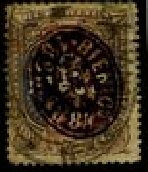Stamp: Previous issue overprinted (Peru 1883)
Previous issue overprinted (Peru 1883)
01 January (Peru ) within release Revenues: Documentary goes into circulation Stamp Previous issue overprinted face value 10 Peruvian centavo
| Stamp Previous issue overprinted in catalogues | |
|---|---|
| Forbin: | For: PE D83 |
Stamp is vertical format.
Previous issue (1874-75) overprinted in red or violet as shown. Used during the civil war period primarily in Lima and in the northern departments, as the southern ones had revolted against Gen. Iglesias, now president, after signing the peace treaty of Ancon on Oct.23, 1883.Also in the issue Revenues: Documentary:
- Stamp - Coat of Arms and Numeral face value 1;
- Stamp - Previous issue overprinted face value 10;
- Stamp - Previous issue overprinted face value 10;
- Stamp - Previous issue overprinted face value 10;
- Stamp - Previous issue overprinted face value 25;
|
Data entry completed
86%
|
|
|---|---|
| Stamp Previous issue overprinted in digits | |
| Country: | Peru |
| Date: | 1883-01-01 |
| Size: | 23 x 29 |
| Perforation: | 14 |
| Emission: | Revenue |
| Format: | Stamp |
| Face Value: | 10 Peruvian centavo |
Stamp Previous issue overprinted it reflects the thematic directions:
A number is a mathematical object used to count, measure, and label. The most basic examples are the natural numbers 1, 2, 3, 4, and so forth. Numbers can be represented in language with number words. More universally, individual numbers can be represented by symbols, called numerals; for example, "5" is a numeral that represents the number five. As only a relatively small number of symbols can be memorized, basic numerals are commonly organized in a numeral system, which is an organized way to represent any number. The most common numeral system is the Hindu–Arabic numeral system, which allows for the representation of any non-negative integer using a combination of ten fundamental numeric symbols, called digits. In addition to their use in counting and measuring, numerals are often used for labels (as with telephone numbers), for ordering (as with serial numbers), and for codes (as with ISBNs). In common usage, a numeral is not clearly distinguished from the number that it represents.

